#76 Component Issues Are Real Reason for ITER Reactor Delay, Former Spokesman Says

Former ITER Spokesman Michel Claessens (left), Current ITER Spokesman Laban Coblentz (right)
Return to ITER Power Facts Main Page
By Steven B. Krivit
September 26, 2021
The ITER organization is using Covid as an excuse to hide new delays and costs caused by component issues, according to Michel Claessens, its former spokesman.
This is the relevant sequence of recent events:
- On June 16-17, 2021, at the ITER Council meeting, the ITER organization advised the council that the project has shifted at least one year behind schedule. Council members were advised that the COVID-19 pandemic and component issues were responsible for the new delays which will also translate to added costs.
- On June 17, 2021, the ITER organization issued a press release titled “Steady Progress Despite Challenges Including COVID-19.” The press release did not disclose any schedule delay or cost increase.
- On Sept. 17, 2021, the ITER organization disclosed at a press conference that the project had fallen behind schedule and that the costs are going to rise — primarily because of COVID-related production delays. The organization did not announce how many years have been added to the schedule. Nor did it provide the estimated amount of the extra costs.
Claessens says the primary cause of the delay is not because of COVID but because of production delays that happened before COVID. He wrote about it in his French and English books about ITER.
Claessens told New Energy Times that the current delay is primarily the result of problems with the European sectors of the vacuum vessel that occurred many years ago, when he was working in the organization from 2011 to 2015. He explained what happened in his book:
Originally, two of the vacuum vessel sectors were to be provided by South Korea, the other seven by Europe. But Europe experienced significant delay because of difficulties unrelated to ITER encountered by three Italian companies involved in the manufacturing. Accordingly, the ITER organization asked South Korea to manufacture two additional sectors. In addition, two more companies were contracted to work on the vacuum vessel.
One is based in Spain and is responsible for producing the poloidal (the most internal) part of three of the sectors, and the other is German and will have the delicate job of welding together each sector using powerful electron beams. This company is the only one in Europe capable of welding pieces as large as the ITER components.
Electron beam welding produces almost no lateral shrinkage, angular distortion, or any other kinds of distortion during or after the welding. This means that sensitive components or those with tight tolerances can retain their carefully manufactured dimensions. But this is not an easy process.
The pieces of the sectors travel by road from Italy to Germany and back again. In summer 2018, engineers in Cadarache noticed defects in some of the pieces as they came back from Germany. Fusion for Energy sent an official complaint to the German company, which triggered an internal investigation. As a result, two of the directors of the company, in charge of welding and quality, respectively, were fired.
The challenge for Europe and Korea now is to complete the manufacturing and the welding of all sectors in the tokamak pit by 2022, in order to keep the project on schedule for First Plasma in 2025.
The new delay puts completion of the reactor construction at 2026 or 2027.
New Energy Times sent the information from Claessens to Laban Coblentz, the current ITER spokesman, and asked him to comment on the discrepancy between his explanation for the delay and Claessens’ explanation. Coblentz did not respond.

